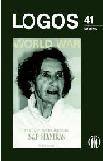FORMŲ GENEZĖ IR JUDĖSENA J. BALTRUŠAIČIO VIDURAMŽIŲ MENO KONCEPCIJOJE
Genesis and Movements of Forms in J. Baltrušaitis' Medieval Art Theory
Author(s): Odeta ŽukauskienėSubject(s): Cultural history
Published by: Visuomeninė organizacija »LOGOS«
Keywords: J. Baltrušaitis; medieval art; movements of forms; genesis; orientalisms; motifs
Summary/Abstract: This work focuses on the genesis and movement of form in J. Baltrušaitis' medieval art theory. The article analyses methodological aspects. The emphasis is put on how oriental antique "motifs" arrive and revive in Western medieval art. According to Baltrušaitis, Western Christian art and architecture were born in the collision of Hellenistic and oriental forms. Baltrušaitis deals not with simple orientalistic influences, but with complicated ways of transmission of "visual formulas". He shows not only how an antique Sumerian Gilgamesh figure transforms into the Christian Daniel, but also reveals that no figure has no origin: it always exists in a form (ornamental form) which can emanate different senses. This work shows how Baltrušaitis analyses the movement and rebirth of antique cosmographic motifs (solar symbols, astrological signs, and circles of planispheres) and ancient Asian architectural constructions in Western medieval culture. He stresses that during periods of historical transformation, the past and future collide, the human memory becomes more active, and the phenomenon of relapse begins.
Journal: LOGOS - A Journal of Religion, Philosophy, Comparative Cultural Studies and Art
- Issue Year: 2005
- Issue No: 41
- Page Range: 191-206
- Page Count: 16
- Language: Lithuanian

